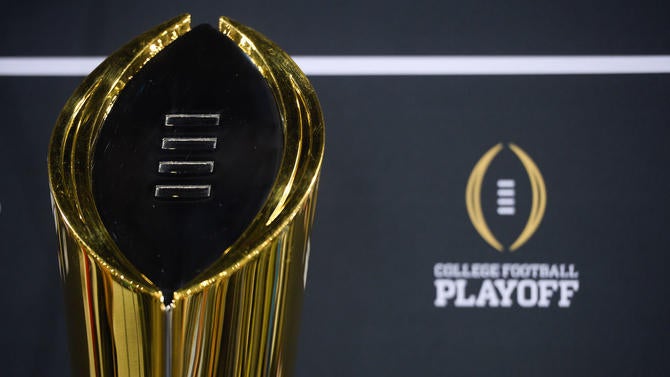With European soccer increasing in popularity in the United States over the last decade, the idea of adopting soccer's relegation system is nothing new among some college football fans.
For those unfamiliar with relegation and how it works, it's really quite simple. Let's use English soccer as our example. There are numerous leagues in England because there are so many teams. There's the top league, known as the Premier League (EPL), which features 20 teams. All the teams in the league play two matches against the other 19 teams, earning three points for a victory, and one point for a draw. At the end of the season, the team with the most points is crowned the champion.
Easy enough, right?
Well, where relegation comes in is at the bottom of the standings -- or table, in British parlance. You see, it's not only the top of the league people pay attention to but the bottom as well. The three teams that finish at the bottom of the standings are relegated -- moved down -- to the lower league. In England, that second league is called the Football League Championship.
This season, Newcastle United, Norwich City and Aston Villa all finished at the bottom of the table, and next season all will play in the Championship rather than the EPL. Meanwhile, the top two teams from the Championship will move up to the EPL. Behind those two teams, the clubs that finished from third place to sixth held a four-game playoff with the winner of that playoff earning the third promotion spot to the EPL.
And there are more leagues below the Championship where the same promotion/relegation system is in place. In theory, that means a team in England's fifth division can play well enough to one day earn a spot in the Premier League -- and vice versa.
You cannot tank for draft picks in European soccer because there is no draft. You must win to survive and keep collecting those giant paychecks that come with being in the Premier League.
Because there is no draft in college sports, and there are so many teams, college football has become a popular sport for fantasizing about a similar system here in the United States. Most of these plans, however, tend to link conferences to each other. For instance, the teams that finished last in the Big Ten would be sent down to the MAC, while the top teams in the MAC would move up to the Big Ten.
My proposal is something much more drastic.
Since the formation of the College Football Playoff and the separation of the Power Five conferences, there's been speculation about the Power Five conferences breaking off entirely from the NCAA and forming their own league. My plan exists in a world where this happens, and along with breaking free, the Power Five expands to include a total of 70 teams -- 14 per league.
Most importantly, instead of the traditional conferences we all know and love, teams would be grouped in new conferences based on their performance.
So what I've done is taken all the teams from the Power Five conferences (64), along with Notre Dame, and added five new teams poached from the independent ranks or the Group of Five (Boise State, BYU, UCF, Cincinnati and Houston) to give this new league 70 teams total.
I then took those 70 teams and broke them off into five new conferences. The new conferences aren't based on current league loyalties or geography. Instead, I took each team's record of their last five seasons and found their combined win percentage in those years. I then ranked all 70 teams based on that win percentage and put them in new conferences based on nothing but that.
The 14 best teams are in the top conference, the next 14 in the second conference, and so on. The only change I made was the five new teams from the Group of Five must start at the bottom because that's just how the Power Five would do things. "You can join us, and you can have access to our money, but you're going to start at the bottom."
Notre Dame is excluded from this because of its previous relationship with the BCS and its partial membership in the ACC. Plus, you know, it's Notre Dame, and that alone has typically been enough to deem the school a Power Five school all along.
Here is how the five conferences would look in the very first year of the plan (all teams listed in order of their win percentage the last five seasons).
| Conference 1 | Conference 2 | Conference 3 | Conference 4 | Conference 5 |
| Alabama | Wisconsin | Penn State | Georgia Tech | Boston College |
| Florida State | TCU | North Carolina | Arkansas | Maryland |
| Clemson | Kansas State | Iowa | NC State | Wake Forest |
| Oregon | South Carolina | Auburn | Pitt | Indiana |
| Ohio State | USC | Utah | Texas Tech | Iowa State |
| Michigan State | Texas A&M | Washington | Tennessee | Kentucky |
| Stanford | Missouri | Miami | Minnesota | Purdue |
| Oklahoma | Nebraska | Northwestern | Vanderbilt | Colorado |
| Baylor | UCLA | Arizona | Syracuse | Kansas |
| LSU | Michigan | West Virginia | Oregon State | Boise State* |
| Georgia | Mississippi State | Texas | Washington State | BYU* |
| Louisville | Florida | Rutgers | Illinois | Cincinnati* |
| Oklahoma State | Virginia Tech | Ole Miss | Cal | Houston* |
| Notre Dame | Arizona State | Duke | Virginia | UCF* |
* Not sorted by win percentage
Things look a lot different, don't they?
I'm sure you have some questions, so I'll answer the ones I'm confident you'd ask.

Why 14 teams per conference? Since the inspiration is European soccer, where leagues play a round-robin schedule, I felt 14 team conferences were the best choice so each team can play every other team in its conference once, providing a 13-game regular season. That's the same number of games most bowl teams will play in a given year. Also, since you're only playing within your conference, it has to be an even amount of teams because then we would need to have at least one team per conference on a bye every week, making scheduling more complicated. Twelve teams (11 games) is not enough television content, and 16 teams (15 games) is simply too many games.
How would the schedule work? The biggest complaint schools will have is having an uneven schedule when it comes to home and road games, which I can't do much about if we're going with an even number of teams. Instead, there'd be a rotation in the schedule. If you play seven games at home in 2016, you'll have six in 2017. Teams that are promoted or relegated to new conferences would simply adopt the schedule of the team they're replacing in the respective conference.
What about the playoff and bowl games? They'll all still exist, just in a different manner, which I'll explain in greater detail while answering the next question.
How will promotion/relegation work? Just like in European soccer, but with a college football twist. We will still crown a national champion, and we will still use the College Football Playoff to do it, but the catch is this: only the 14 teams in Conference 1 will be eligible. This may seem unfair, but let's be real here: When any college football season starts how many teams have a realistic shot at winning the national title? Eight? Ten? Maybe 12?
Things really won't change all that much when it comes to the national title. The CFP will consist of the four teams at the top of the standings in Conference 1 and go on from there.
Meanwhile, the three teams that finish at the bottom of Conference 1 will move down to Conference 2 the following season. If there are more than three teams at the bottom of the conference with the same record, head-to-head results would serve as the first tiebreaker for relegation, then point differential as a second tiebreaker.
In Conference 2, the top two teams in the standings will automatically qualify for promotion to Conference 1. Then, the next four teams in the standings (third through sixth place) will play a four-team playoff to earn the third promotion spot. This method gets replicated for every league, of course.
What this will do is give us all so many more meaningful games as the season -- and postseason -- goes on. It would also allow fans of teams who traditionally struggle (think Conferences 4 and 5) the chance to actually win something of consequence. These playoff games would all be played in existing bowls, giving even the lesser bowls more significance and thereby increasing the ratings, which leads to more money. (And we all know how much schools like money.)
But there would still be plenty of bowls without teams! That's not a question, but I'll allow it. While that's true, nobody would stop those other bowls from functioning. Any bowl game that wants to continue existing would still have plenty of other schools not involved in the various playoffs to choose from. What these bowls could do is choose traditional rivals that have been separated by the new conferences and pit them against one another, making their game much more attractive both to TV and traveling fan bases. If neither Alabama or Auburn qualify for a playoff spot in their conferences, the Iron Bowl could be played in an actual bowl game. It wouldn't be ideal, but it would be better than the two not playing at all.
How would the money and TV work? We'd basically see the same system we have in professional sports. Instead of each conference negotiating its own television deal, the Power Five would would sell the television rights to each conference separately. Obviously Conferences 1 and 2 would command the most money, but where things change is that every conference will share in the revenue. Every dollar brought in by the five conference television deals will be pooled together and distributed evenly among the 70 schools.
Also, each TV deal would be the same length of time, ensuring that all deals expire simultaneously. This means television networks would all be bidding against one another at the same time for the rights, driving up the price for each one. Nobody will want to be left without at least one conference. And even if Conference 3 doesn't play for a national title, it's still going to include schools with large fan bases, making it attractive to networks for the ratings alone.
But what about the recruiting advantages of Conference 1? Don't teams that play for national titles already have that advantage? Recruiting has never been an even playing field, and this system won't change much. If you move up in conference, your recruiting will likely improve, and as you drop, it'll likely become more difficult. All of which is basically the same way it works now.
Great idea in theory, Tom. Thanks. But can I see it in action? Sure!
To use an example of how it might all work, we'll turn back the clock to last season. We'll use each team's regular season record from 2015, ignoring the fact that many of the schools in each new conference didn't play one another, to come up with how the standings would have looked.
Asterisk (*) denotes playoffs, bold promotion, underline relegation
| Conference 1 | Conference 2 |
| Clemson (12-0)* | TCU (10-2) |
| Alabama (11-1)* | Florida (10-2) |
| Oklahoma (11-1)* | Wisconsin (9-3)* |
| Michigan State (11-1)* | Michigan (9-3)* |
| Ohio State (11-1) | USC (8-4)* |
| Florida State (10-2) | Texas A&M (8-4)* |
| Stanford (10-2) | UCLA (8-4) |
| Oklahoma State (10-2) | Mississippi State (8-4) |
| Notre Dame (10-2) | Kansas State (6-6) |
| Oregon (9-3) | Virginia Tech (6-6) |
| Baylor (9-3) | Arizona State (6-6) |
| Georgia (9-3) | Missouri (5-7) |
| LSU (8-3) | Nebraska (5-7) |
| Louisville (7-5) | South Carolina (3-9) |
College Football Playoff: Clemson vs. Michigan State, Alabama vs. Oklahoma
Relegated to Conference 2: Georgia (lowest win% of 9-3 teams over last five years, losing tiebreaker), LSU, Louisville
Promoted to Conference 1: TCU, Florida
Promotion Playoff 2: Wisconsin vs. Texas A&M, Michigan vs. USC
Relegated to Conference 3: Missouri, Nebraska, South Carolina
| Conference 3 | Conference 4 | Conference 5 |
| Iowa (12-0) | Pitt (8-4) | Houston (11-1) |
| North Carolina (11-1) | Tennessee (8-4) | BYU (9-3) |
| Northwestern (10-2)* | Washington State (8-4) * | Boise State (8-4)* |
| Utah (9-3)* | Arkansas (7-5)* | Cincinnati (7-5)* |
| Ole Miss (9-3)* | NC State (7-5)* | Indiana (6-6)* |
| Miami (8-4)* | Texas Tech (7-5)* | Kentucky (5-7)* |
| Penn State (7-5) | Cal (7-5) | Colorado (4-9) |
| West Virginia (7-5) | Minnesota (5-7) | Boston College (3-9) |
| Duke (7-5) | Illinois (5-7) | Maryland (3-9) |
| Auburn (6-6) | Vanderbilt (4-8) | Wake Forest (3-9) |
| Washington (6-6) | Syracuse (4-8) | Iowa State (3-9) |
| Arizona (6-6) | Virginia (4-8) | Purdue( 2-10) |
| Texas (5-7) | Georgia Tech (3-9) | Kansas (0-12) |
| Rutgers (4-8) | Oregon State (2-10) | UCF (0-12) |
Promoted to Conference 2: Iowa, North Carolina
Promotion Playoff 3: Northwestern vs. Miami, Utah vs. Ole Miss
Relegated to Conference 4: Arizona, Texas, Rutgers
Promoted to Conference 3: Pitt, Tennessee
Promotion Playoff 4: Washington State vs. Texas Tech, Arkansas vs. NC State
Relegated to Conference 5: Virginia, Georgia Tech, Oregon State
Promoted to Conference 4: Houston, BYU
Promotion Playoff 5: Boise State vs. Kentucky, Cincinnati vs. Indiana
Now, if we assume that the No. 3 seeds all win the Promotion Playoffs in each conference, this is how the new conferences would look the following season.
Bold denotes newly-promoted teams, underline for newly-relegated teams
| Conference 1 | Conference 2 | Conference 3 | Conference 4 | Conference 5 |
| Clemson | Georgia | Missouri | Arizona | Virginia |
| Alabama | LSU | Nebraska | Texas | Georgia Tech |
| Oklahoma | Louisville | South Carolina | Rutgers | Oregon State |
| Michigan State | Michigan | Utah | Arkansas | Cincinnati |
| Ohio State | USC | Ole Miss | NC State | Indiana |
| Florida State | Texas A&M | Miami | Texas Tech | Kentucky |
| Stanford | UCLA | Penn State | Cal | Colorado |
| Oklahoma State | Mississippi State | West Virginia | Minnesota | Boston College |
| Notre Dame | Kansas State | Duke | Illinois | Maryland |
| Oregon | Virginia Tech | Auburn | Vanderbilt | Wake Forest |
| Baylor | Arizona State | Washington | Syracuse | Iowa State |
| TCU | Iowa | Pitt | Houston | Purdue |
| Florida | North Carolina | Tennessee | BYU | Kansas |
| Wisconsin | Northwestern | Washington State | Boise State | UCF |
This system would continue on with teams being promoted or relegated to new conferences every year.
As I stated a few thousand words ago, this plan will likely never happen. It would cause too much of an uproar among the schools and fans because, even if this idea is fun to contemplate and may actually be better for college football long-term, it would uproot a lot of tradition and history that the game's been built upon for a hundred-plus years.
This is simply another interesting idea, one that could possibly improve the game in a lot of different ways. And I wouldn't mind seeing it in action one day.
















